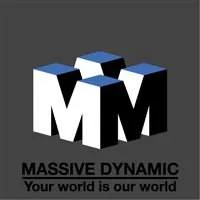Often when the protagonist of a speculative narrative must struggle against an unfeeling world, that world is represented by a faceless conglomerate, a near-governmental corporation which seems to control facets of society wherever the character looks.
So in Stock and Trade, our latest genre fiction feature series, we’re looking at fictional corporations. Today, we’re featuring Massive Dynamic.

Massive Dynamic is the huge international corporation in the story-world of the Fringe television show. During the first season, they played well the part of the faceless corporation, which the protagonists had to fight against for information and humanity, but through the second season, Massive Dynamic’s story becomes more integral to the broader mythology, and by the conclusion of the third season, they have become part of the protagonist team.
Massive Dynamic was founded when William Bell’s medical devices company merged with a jet engine manufacturer, also partly owned by Bell, to create a larger corporation with a greater scope.
Over the following years, Massive Dynamic expanded into a wide variety of fields including telecom, transportation, entertainment, and energy. With holdings in almost every field, and labs and offices across the world, Massive Dynamic became a perfect place to hide Bell’s experiments in Fringe Science.
Many of Massive Dynamics’ advances and products come from the genius fringe science developments of Bell, and his former partner, Walter Bishop, and from Bell’s foray into an alternate dimension, the technology for which Bishop developed. While he’s gone, Bell leaves Nina Sharp, his COO, in charge of the day-to-day operation of the company, and this is the way the audience ids first introduced to the corporation.

When the secret Fringe division of the FBI, which investigates events thought to involve fringe science, is formed, many of their opening cases seem to be tied to the mysterious corporation, and Sharp is an enigmatic figure who seems determined to supply the team with as little information as possible, declaring either company secrets or outright non-involvement.
During this antagonistic phase, the company ties into the greater theme of the Fringe story: the dangers and responsibilities of uncontrolled scientific research.
With the death of Bell, who was still majority owner of the company, ownership passed to Bishop, who had only a few years before been released from a mental hospital by the FBI to help them with their fringe science investigations, and who has very little actual business sense.
This has however vastly decreased the conflicts between the protagonists and the corporation, allowing them to work together on the most recent cases. Of course, everyone on the show has bigger challenges to overcome at this point.
Come back tomorrow, when we’ll be taking a look at ENCOM. If you have an idea for a corporation we could feature in this series, let us know in the comments.






